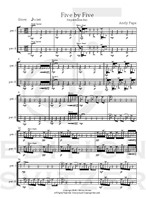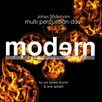
Five by Five
Composer: Andy Pape
Instrument: Multi Percussion Duo
Level: Advanced
Published: 2011
Price: €20.00
Item details
-
Description +
-
Duration: 9 min.
The title "Five by Five" alludes to the architectural blueprint for the piece in its entirety. Each beat of the piece has, instead of the traditional four 16th notes, five 16th notes. Each measure has in turn five beats, five measures comprise a period (wavy barline). Five of these periods give way to a section (double barline), five sections comprise a session, which is to say the whole piece. In this way, there are in all five to the fifth power (3,125) 16th notes.
The instrument set-up is a suggestion, and can be altered to fit the performance situation and the performers involved.
The drums, and effects of percussion II should be of a lower sonority than percussion I. That is to say, that perc.II's floor tom should sound lower than perc.I's floor tom. Perc.II's cow bell, lower than perc.I's cowbell etc. The crotales should also be of different pitches, although reasonably close to each other in pitch. The crotales can also be replaced with other bell-like sonorities, i.e. prayer bells etc.
The piece starts with both percussionists playing with plastic brushes. Between measures 46 and 52 both percussionists are asked to change from plastic brushes to large sticks or hard mallets. This is done by picking up one stick during the rest in measure 46, and thus having a stick and a brush in the one hand from m. 46 to 51. During m. 51-52 the brushes are put down, and the second stick taken up.
First performed by Matthew Coley and Ronni Kot Wenzell
Five by Five is dedicated to Ronni Kot Wenzell and kindly supported by the Danish Arts Foundation.
-
-
Instrumentation +
-
Percussion Duo
Required Instruments:
Player 1:
1 Splash Cymbal
3 Tom Toms
1 Crotale
1 Cow Bell
1 Ribbon Crash
1 Wood Block
1 Bass Drum
Player 2:
1 Chinese Cymbal
3 Tom Toms
1 Crotale
1 Cow Bell
1 Ribbon Crash
1 Wood Block
-
-
Reviews +
-
Percussive Notes, May, 2012
When providing a difficulty rating for this duet, my gut feeling was to use the one provided by the composer (V). However, the extreme demands should only be attempted by advanced chamber musicians and warrants a slightly higher rating. As the title suggests, there is a strong influence of the number five. Andy Pape states, “Each beat of the piece has, instead of the traditional four sixteenth notes, five sixteenth notes. Each measure has in turn five beats, five measures comprise a period (wavy barline). Five of these periods give way to a section (double barline), five sections comprise a session, which is to say the whole piece. In this way, there are in all five to the fifth power (3,125) sixteenth notes.”
Utilizing a distinct blueprint, the work begins with dependence between the parts. Executed with brushes, the performers remain in unison with few exceptions. The second section becomes increasingly more difficult as motives are imitated and overlapped. With each performer using different groupings of eighth notes and sixteenth notes, the intense rhythmic complexity of the ensemble will frustrate even experienced performers. Switching to sticks or hard mallets, the third section presents motives similar to the previous sections. The density increases during the last two sections. With a persistent pulse of sixteenth notes, syncopated accents and groupings of thirty-second notes are passed between the parts.
The composer provides exceptional information in the score. Descriptive “weighted” and “accented” notes are included to emphasize the five-note groupings. Due to the demands of the ensemble, these inflections are essential for the performers to stay together. Clear expression marks indicate expansive dynamic contrast, sometimes changing on each beat of a measure.
—Darin Olson
-
-
Credits +
-
Credits Front Cover Graphics and Layout: Ronni Kot Wenzell
Engraving: Andy Pape & Johan Svitzer
Printed in Copenhagen, Denmark
Copyright © Edition Svitzer
www.editionsvitzer.com
-




